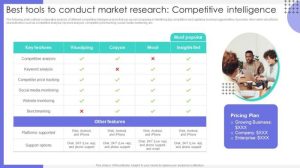
Starting off with Sales conversion strategies, get ready to dive into the world of boosting sales through innovative and proven techniques. This topic is all about increasing your revenue and maximizing conversion rates to take your business to the next level.
Get ready to uncover the secrets behind successful sales conversion strategies and how they can revolutionize your approach to marketing and sales.
Market Research
Market research plays a crucial role in developing effective sales conversion strategies by providing valuable insights into the target market, customer behavior, and preferences. It helps businesses understand their audience better and tailor their approach to meet their needs and expectations.
Key Metrics for Market Research
- Demographics: Understanding the age, gender, income level, education, and other demographic factors of your target audience can help in creating targeted marketing campaigns.
- Psychographics: Analyzing the lifestyle, values, interests, and attitudes of customers can provide a deeper understanding of their motivations and buying behavior.
- Competitor Analysis: Studying competitors’ strategies, pricing, products, and customer reviews can help identify gaps in the market and opportunities for differentiation.
- Market Trends: Keeping track of industry trends, consumer preferences, and emerging technologies can help businesses stay ahead of the curve and adapt their strategies accordingly.
Understanding Customer Behavior and Preferences
Market research helps businesses gain insights into customer behavior and preferences by analyzing data such as purchase history, website interactions, feedback, and surveys. By understanding what motivates customers to make a purchase and what factors influence their decision-making process, businesses can tailor their products, pricing, and marketing strategies to effectively engage and convert potential leads into loyal customers.
Marketing Software

In the digital age, marketing software plays a crucial role in helping businesses implement sales conversion strategies effectively. These tools offer a wide range of features to streamline marketing efforts and improve conversion rates.
Popular Marketing Software Tools
- HubSpot: Known for its inbound marketing capabilities, HubSpot offers a comprehensive suite of tools for lead generation, email marketing, and analytics.
- Mailchimp: Ideal for email marketing campaigns, Mailchimp provides easy-to-use templates and automation features to engage with customers.
- Salesforce Marketing Cloud: A robust platform for personalized marketing campaigns, Salesforce Marketing Cloud integrates customer data for targeted messaging.
Comparison of Marketing Software Options
- Features: While HubSpot focuses on inbound marketing, Salesforce Marketing Cloud offers advanced personalization features, and Mailchimp excels in email marketing automation.
- Suitability: Small businesses may benefit more from Mailchimp’s user-friendly interface, while larger enterprises might prefer the scalability of Salesforce Marketing Cloud.
Role of Marketing Automation Software
Marketing automation software plays a vital role in enhancing sales conversions by automating repetitive tasks, nurturing leads, and delivering personalized content to prospects. By streamlining marketing processes and improving customer engagement, businesses can effectively drive conversions and boost revenue.
Public Relations
Public relations play a crucial role in shaping how a company is perceived by the public. A strong public relations strategy can significantly impact sales conversion rates by building trust, credibility, and positive brand image among consumers.
Impact on Sales Conversion Rates
Effective public relations efforts can create buzz around a product or service, generating interest and increasing consumer confidence. By securing positive media coverage, managing crises effectively, and engaging with customers through various channels, companies can build strong relationships with their target audience, ultimately leading to higher sales conversion rates.
- Securing positive media coverage through press releases, interviews, and media partnerships can increase brand visibility and credibility, influencing consumer purchasing decisions.
- Managing crises transparently and proactively can help companies maintain their reputation and trust among customers, preventing potential sales losses due to negative publicity.
- Engaging with customers through social media, events, and community initiatives can create a loyal customer base, leading to repeat purchases and positive word-of-mouth referrals.
Examples of Successful PR Campaigns
- The Dove “Real Beauty” campaign challenged beauty standards and promoted self-acceptance, leading to increased brand loyalty and sales.
- Airbnb’s “We Accept” campaign addressed discrimination and promoted inclusivity, resonating with consumers and driving customer growth.
- Nike’s partnership with Colin Kaepernick sparked controversy but ultimately strengthened the brand’s connection with socially conscious consumers, resulting in higher sales.
Building Brand Credibility
Building brand credibility through effective public relations efforts is essential for long-term success. By consistently delivering on promises, being transparent, and engaging authentically with stakeholders, companies can establish trust and credibility, ultimately driving sales and customer loyalty.
- Consistent messaging and brand storytelling can create a compelling narrative that resonates with consumers, building emotional connections and brand loyalty.
- Transparency in communication and addressing customer concerns openly can enhance brand credibility and trust, leading to increased sales and customer retention.
- Audience engagement through interactive campaigns, events, and social media interactions can humanize the brand, making it relatable and trustworthy to consumers.
Marketing Sales
In the realm of sales conversion strategies, marketing sales techniques play a crucial role in turning potential leads into actual customers. By effectively combining these two components, businesses can maximize their conversion rates and ultimately increase revenue.
Relationship between Marketing Sales Techniques and Sales Conversion Strategies
- Marketing sales techniques involve the methods and strategies used to attract, engage, and persuade potential customers to make a purchase.
- When these techniques are aligned with sales conversion strategies, such as optimizing the sales funnel, improving customer experience, and implementing targeted marketing campaigns, businesses can effectively guide leads through the buying process.
- This alignment ensures that marketing efforts are not only driving traffic and generating leads but also successfully converting those leads into paying customers.
Innovative Marketing Sales Tactics to Boost Conversion Rates
- Utilizing personalized marketing strategies, such as targeted email campaigns based on customer behavior and preferences, can significantly increase conversion rates by delivering relevant content to potential customers.
- Implementing chatbots and AI-powered tools to provide real-time customer support and assistance can enhance the overall shopping experience and encourage conversions.
- Creating interactive and engaging content, such as quizzes, polls, or virtual try-on experiences, can capture the attention of potential customers and drive them towards making a purchase.
Role of Personalized Marketing in Improving Sales Conversion Rates
- Personalized marketing involves tailoring marketing messages and offers to meet the specific needs and preferences of individual customers.
- By leveraging customer data and insights, businesses can create personalized marketing campaigns that resonate with their target audience and lead to higher conversion rates.
- Personalization can help build stronger relationships with customers, increase brand loyalty, and ultimately drive more sales by delivering a more relevant and personalized shopping experience.
Advertising and Telemarketing
When it comes to driving sales conversions, businesses often rely on a combination of traditional advertising and telemarketing strategies. Let’s explore the effectiveness of each method and the ethical considerations that should be kept in mind.
Effectiveness of Traditional Advertising vs. Telemarketing
Traditional advertising, such as print ads, TV commercials, and billboards, can reach a wide audience and build brand awareness over time. However, telemarketing allows for direct interaction with potential customers, offering a personalized touch that can lead to immediate sales.
- Traditional advertising is beneficial for creating brand recognition and reaching a broad audience.
- Telemarketing provides a more personalized approach and can result in higher conversion rates due to direct communication.
- Combining both methods can create a comprehensive marketing strategy that leverages the strengths of each approach.
Ethical Considerations in Advertising and Telemarketing
When using advertising and telemarketing for sales, it’s crucial to prioritize ethical practices to maintain customer trust and loyalty.
- Respect customers’ privacy and adhere to do-not-call lists to avoid spamming or bothering individuals.
- Be transparent about products or services offered and avoid using deceptive tactics to lure in customers.
- Ensure that all advertising and telemarketing efforts comply with relevant regulations and guidelines to prevent legal issues.
Integrating Advertising and Telemarketing Strategies
To maximize sales conversion opportunities, businesses can integrate advertising and telemarketing strategies effectively.
- Use advertising to create brand awareness and spark interest in products or services, then follow up with telemarketing to engage potential customers on a more personal level.
- Segment your target audience based on their preferences and behaviors to tailor advertising and telemarketing efforts accordingly.
- Track the performance of both advertising and telemarketing campaigns to analyze what works best and optimize strategies for improved sales conversions.
Web Design and Development
User-friendly web design plays a crucial role in driving sales conversions. A well-designed website not only attracts visitors but also guides them through a seamless journey towards making a purchase. Here are some key elements that can influence visitor behavior and ultimately lead to increased sales:
Website Elements for Increased Sales
- Clear Call-to-Action (CTA) Buttons: Strategically placed CTA buttons that stand out can prompt visitors to take action, such as making a purchase or signing up for a newsletter.
- Intuitive Navigation: Easy navigation ensures that visitors can quickly find what they are looking for, reducing bounce rates and increasing the likelihood of conversion.
- High-Quality Visuals: Compelling images and videos can capture visitors’ attention and showcase products or services effectively, boosting engagement and trust.
- Customer Reviews and Testimonials: Social proof in the form of customer reviews and testimonials can build credibility and encourage potential customers to make a purchase.
- Mobile Optimization: With the increasing use of mobile devices, having a responsive design that adapts to different screen sizes is essential for capturing sales across various devices.
Responsive web design is particularly crucial in optimizing sales conversion rates across different devices. A responsive website automatically adjusts its layout and content based on the device being used, ensuring a consistent and user-friendly experience for visitors. By providing a seamless browsing experience regardless of the device, responsive design can enhance usability, engagement, and ultimately, sales conversions.
Making Money Online
In today’s digital age, leveraging online platforms and resources is crucial for enhancing sales conversion strategies and maximizing revenue potential. E-commerce and affiliate marketing have revolutionized the way businesses operate and offer endless opportunities for generating income and increasing sales. Here are some tips for monetizing online content and driving sales through digital channels.
Leveraging E-commerce
E-commerce platforms provide a convenient and efficient way to sell products or services online. By setting up an online store, businesses can reach a wider audience and attract customers from around the globe. It’s essential to optimize product listings, provide secure payment options, and offer excellent customer service to boost sales and build customer loyalty.
Harnessing Affiliate Marketing
Affiliate marketing allows businesses to partner with influencers, bloggers, or other websites to promote their products or services. By offering commissions for sales generated through affiliate links, businesses can increase brand visibility and attract new customers. It’s important to choose the right affiliates, track performance metrics, and provide them with the necessary resources to effectively market your offerings.
Monetizing Online Content
Creating valuable content, such as blog posts, videos, or podcasts, can attract an audience and drive traffic to your website. Monetize your content by incorporating affiliate links, sponsored posts, or selling digital products like e-books or online courses. Engage with your audience through social media and email marketing to promote your content and encourage sales.
Driving Sales through Digital Channels
Utilize digital marketing tactics like search engine optimization (), pay-per-click (PPC) advertising, and social media marketing to drive traffic to your website and increase sales. Develop a cohesive digital marketing strategy that targets your ideal customers and utilizes data analytics to track and optimize your campaigns. Personalize your messaging and offers to enhance the customer experience and improve conversion rates.
Outcome Summary

In conclusion, Sales conversion strategies offer a powerful toolkit for businesses looking to enhance their sales performance. By implementing the right tactics and leveraging key strategies discussed, you can unlock the full potential of your marketing efforts and drive significant growth in your revenue.
FAQ Corner
How important is market research in sales conversion strategies?
Market research plays a crucial role in understanding customer behavior and preferences, which are essential for optimizing sales strategies.
What role does marketing automation software play in enhancing sales conversions?
Marketing automation software streamlines processes, enables personalized marketing, and improves overall efficiency in converting leads into sales.
How can web design influence sales conversions?
User-friendly web design elements can create a seamless customer experience, leading to increased conversions and sales.
What are some ethical considerations when using advertising and telemarketing for sales?
Respecting consumer privacy, providing accurate information, and avoiding aggressive tactics are key ethical considerations in advertising and telemarketing.






